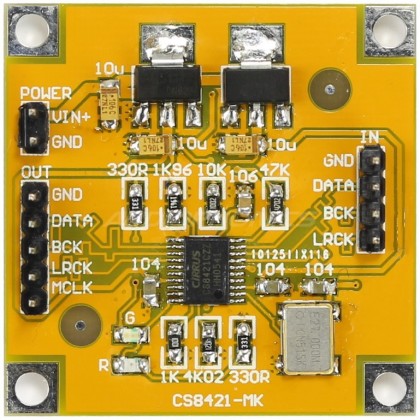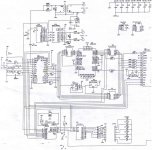Upsampling (and not oversampling) -- via a dedicated SRC chip like AD1896 or Cirrus CS8421 -- was somewhat popular in the late 1990s and early 2000s in standalone D/A processors.
And then the fad seemed to vanish. Not sure why the use of upsampling -- via ASRC -- went out of favor?
As a matter of fact ... not sure why it became popular in the first place ... maybe ASRCs kinda/sorta "re-clocked" the I2S lines in a clean way, all in the convenience of one IC device ?
Anyway ...
The ASRC chips are still around and stocked by Mouser and Digikey, at low volumes or only bulk qtys, and pretty at high $ for each chip. eBay has them for cheaper.
My parts bin has quite a few of them, many models and manufs, collected over 15 yrs ago, never used, but ready-to-go on micro PCBs. So I might experiment -- see what the old craze was about.
Looked on Ali for kit PCBs and found none.
Did find this French PCB module based on that 20-pin CS8421 device:
https://www.audiophonics.fr/en/inte...verter-module-cs8421-32bit192khz-p-11456.html
And then the fad seemed to vanish. Not sure why the use of upsampling -- via ASRC -- went out of favor?
As a matter of fact ... not sure why it became popular in the first place ... maybe ASRCs kinda/sorta "re-clocked" the I2S lines in a clean way, all in the convenience of one IC device ?
Anyway ...
The ASRC chips are still around and stocked by Mouser and Digikey, at low volumes or only bulk qtys, and pretty at high $ for each chip. eBay has them for cheaper.
My parts bin has quite a few of them, many models and manufs, collected over 15 yrs ago, never used, but ready-to-go on micro PCBs. So I might experiment -- see what the old craze was about.
Looked on Ali for kit PCBs and found none.
Did find this French PCB module based on that 20-pin CS8421 device:
https://www.audiophonics.fr/en/inte...verter-module-cs8421-32bit192khz-p-11456.html
Those CS8421 boards really are a handy tool. Easy format converting included, just needs some 16k resistors.
Its all what the ESS chips are about so what happened was that it moved into the DAC chip - the OS/ASRC fad is still alive and thriving.
//
//
What is the difference, from your point of view?Upsampling (and not oversampling)
1) I think, because ASRC - is the additional chip, but upsampler (DF) is now inside all DAC chips.And then the fad seemed to vanish. Not sure why the use of upsampling -- via ASRC -- went out of favor?
2) ESS DACs have ASRC inside.
P.S. The best ASRC right now is the AK3137, I used it for older R2R DACs that needed an external DF.
philipsmarantz said:
Upsampling (and not oversampling)
Just enter the query into Google:What is the difference, from your point of view?
https://www.diyaudio.com/community/...-and-up-sampling-whats-the-difference.320602/
https://www.audioholics.com/audio-technologies/upsampling-vs-oversampling-for-digital-audio
https://www.audiosciencereview.com/...s-up-sampling-differ-from-over-sampling.3440/
https://www.whatsbestforum.com/thre...mpling-and-oversamplng-which-is-better.21888/
https://samplerateconverter.com/educational/oversampling
https://www.head-fi.org/threads/dac-oversampling-vs-upsampling.201330/
https://dcs.community/t/why-need-to-upsample/4374/6
Now we have a whole bunch of links with contradictory statements, but still don't know what you mean by these terms. Why don't you just answer the question?
To answer your question: an advantage of asynchronous sample rate conversion in a DAC is that it can use a normal, non-tunable, crystal oscillator and still synchronize to a source that runs on a different clock.
To answer your question: an advantage of asynchronous sample rate conversion in a DAC is that it can use a normal, non-tunable, crystal oscillator and still synchronize to a source that runs on a different clock.
Last edited:
I know the difference, but I asked about YOUR opinion.Just enter the query into Google:
I stated it in the OP.I know the difference, but I asked about YOUR opinion.
You mean you call it upsampling and not oversampling when it is done by an asynchronous sample rate converter chip? Fair enough.
Anyway, the ability to use a fixed locally generated clean clock is the only advantage I'm aware of. It's certainly the reason why I used asynchronous sample rate conversion in my valve DAC. I didn't manage to make a reactance-valve-tuned crystal oscillator with a wide enough tuning range to support the frequency tolerances specified for "high accuracy" equipment in the S/PDIF standard, and the "normal accuracy" and varispeed specs were completely impossible to meet.
Anyway, the ability to use a fixed locally generated clean clock is the only advantage I'm aware of. It's certainly the reason why I used asynchronous sample rate conversion in my valve DAC. I didn't manage to make a reactance-valve-tuned crystal oscillator with a wide enough tuning range to support the frequency tolerances specified for "high accuracy" equipment in the S/PDIF standard, and the "normal accuracy" and varispeed specs were completely impossible to meet.
I'm not sure what I mean!
What I "meant" in the OP is that ASRC is acting like a buffer, or re-clocker. Similar to 74HC glue logic -- just getting the timing into better shape.
The various datasheets of the ASRC chips do go into quite a bit of theory and math as to how they work and their internal architecture.
One of the strangest uses of upsampling was in certain Musical Fidelity DACs. They offered selectable 96k and 192k via a rear button. Looking at the schematics of the MF, there seems to have been two SRCs used (????). CS8420 followed by a NPC SM5849AF, and then a PCM1738 dac. I'm guessing both ASRCs were necessary to achieve 192k.
What I "meant" in the OP is that ASRC is acting like a buffer, or re-clocker. Similar to 74HC glue logic -- just getting the timing into better shape.
The various datasheets of the ASRC chips do go into quite a bit of theory and math as to how they work and their internal architecture.
One of the strangest uses of upsampling was in certain Musical Fidelity DACs. They offered selectable 96k and 192k via a rear button. Looking at the schematics of the MF, there seems to have been two SRCs used (????). CS8420 followed by a NPC SM5849AF, and then a PCM1738 dac. I'm guessing both ASRCs were necessary to achieve 192k.
My main question is about what to feed the "clock" input (not BCK) of an ASRC chip.
If you look at these two boards, you'll also note they have an osc.


I am assuming that if I'm coming off an Amanero or other USB-I2S adapters, I just use the MCK? Correct?
The Musical Fidelity DAC seems to be distributing the same osc to both ASRCs and the PCM1738. I am assuming this is the MCK or Reference Clock.
If you look at these two boards, you'll also note they have an osc.


I am assuming that if I'm coming off an Amanero or other USB-I2S adapters, I just use the MCK? Correct?
The Musical Fidelity DAC seems to be distributing the same osc to both ASRCs and the PCM1738. I am assuming this is the MCK or Reference Clock.
Attachments
You could use the Amanero clock if it complies with the requirements in the datasheet. If both the input and output sample rates have a fixed relation to that clock, you are effectively using the asynchronous sample rate converter as a synchronous sample rate converter, but there is nothing wrong with that.
Lots of pins, esp on the AD. Some weird supply voltage requirements, too. 2.5v, etc.
Hoping I can just ground most pins except I2S and pwr/gnd pins.
Hoping I can just ground most pins except I2S and pwr/gnd pins.
Just digging a bit more into how common ASRC up-sampling has been.
I thought it died out in the early to mid aughts. Nope!
Benchmark, Arcam, BelCanto, and others seem to have used AD1896 and SRC4192 and CS842x for much later. Early to mid '10s at least.
I thought it died out in the early to mid aughts. Nope!
Benchmark, Arcam, BelCanto, and others seem to have used AD1896 and SRC4192 and CS842x for much later. Early to mid '10s at least.
So I might experiment -- see what the old craze was about.
My personal in interest in using these chips was jitter reduction. As long as the asrc was fed a good clock the end result was very acceptable. As soon as async usb boards became available i felt no further need to use an asrc, to my ears it even became detrimental to SQ.
For me the ASRC is used in a Minidsp MiniSharc. Ripped CD files are converted 44.1Khz to 48K or 96K as needed in the DSP.
I worry less about the jitter from a Raspberry Pi with the ASRC's low jitter transfer bandwidth.
I worry less about the jitter from a Raspberry Pi with the ASRC's low jitter transfer bandwidth.
This may be operating-system dependent.As soon as async usb boards became available i felt no further need to use an asrc, to my ears it even became detrimental to SQ.
Benchmark, way back in late 2007, experimented with both settled on synchronous USB -- asynch USB Amanero and XMOS may have been unavail back then:
https://www.stereophile.com/headphones/108bench/index.html
Also the quality of the Amanero USB board may only be so-so. Compared to, say, a TAS1020B + SRC4192.
I'm still unclear as to whether jitter optimization is why an ASRC might improve sound (subjective). It might be due to the same dreamy magic that improves sonics when going thru a separate preamp + power amp. Rather than much simpler (shorter trace paths, etc) integrated. Or a DAC with volume control (straight into a pwr amp) -- but sonics improve if you first put it thru, say, a good Krell pre-amp.. According to Benchmark's Elias Gwinn (footnote 1), the DAC1 USB runs in the USB protocol's "synchronous" mode, to allow the host PC to, at all times, send audio data at the original sample rate of the audio being played. If the PC (or, more specifically, Windows XP's kmixer DLL) is not forced to do sample-rate conversion, it can maintain bit-transparent operation. "There is a tradeoff, of course," said Gwinn: "significant amounts of jitter arrive at the DAC1. This is not a problem for the DAC1, however, because Benchmark's UltraLock clocking system makes it immune to jitter."
It's a matter of personal preference, especially for those who like "embellished" sound.that improves sonics when going thru a separate preamp + power amp.
Some people want the most undistorted sound, while others want "harmonics that are pleasant to the ear" (from where 13-bit DACs, NOS, NFB-less amplifiers, fullrange speakers and other heresy, which are generously used with k$ cables). 😉
- Home
- Source & Line
- Digital Line Level
- Revisiting ASRC (sample rate conversion) and up-sampling


